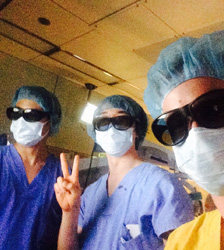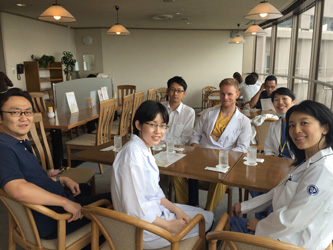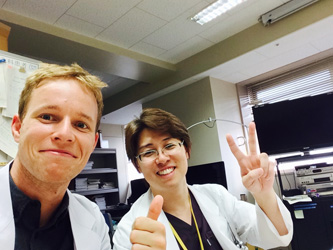Clinical Exchange in Japan
Welcome to Japan and Nagoya University school of Medicine!
Experience Report - Exchange at Nagoya University Hospital through the NUPACE
Morten Dybdahl Krebs - University of Copenhagen
Period:2015/4/1 – 7/3
My name is Morten Krebs and I’m a 26 year old medical student from University of Copenhagen, currently in my final year of the masters program.
During the summer semester 2015 I was lucky to do a 3 month clinical clerkship at Nagoya University Hospital.
I visited the following departments during my three month in the hospital:
Department of Oto-rhino-laryngology, Department of Neurosurgery, Department of Neurology, Department of Ophthalmology and Department of Dermatology,
Oto-rhino-laryngology - head and neck surgery
I spent my first four weeks in Japan in the ENT department. Three days per week I spent in the Operating room, where I had the opportunity to see tumor surgery (including parotid gland tumors, tongue tumors, hypopharyngeal tumor and neck dissection), ear surgery for otosclerosis, cochlear implantation
The remaining days I would spent in the out patient clinic either in the vertigo clinic, in the ear clinic, in the nose and throat clinic.I also had a chance to follow the younger resident doctors during their ward rounds.
The department had an evening conference two times per week, which they did in english.
Though it is a busy department Dr. Nishio, Dr. Fujimoto, and Dr. Sone always took their time to explain about the patients and procedures.
Three Japanese students were also staying at the department, and they took very good care of me. They would always help me by translating the patients journals or translating patient interviews. Also they helped me a lot with recommendations for weekend trips, local restaurants and places to visit in Nagoya.
Neurosurgery
Most of my time in the neurosurgery department I spent following the procedures in the operating room. I had the opportunity to see vascular microsurgery, transsphenoidal tumor surgery, deep brain stimulation, endovascular surgery, neonatal neurosurgery and awake tumor surgery with intraoperative MRI.
The surgeons would often hand me articles about the procedure they were performing and be ready to discuss the current evidence for the treatment.
One interesting example is the STA-MCA anastomosis surgery in carotid occlusion disease, which has generally abandoned after the COSS study showed that the results were not significantly better than conservative treatment. However in Japan the procedure is still being performed since a Japanese study showed better results. Wether the difference lies in post- or perioperative care, surgical skills or something else I don’t know, but indeed it was curious.
The department did their evening conferences in english so I had a change to follow the postoperative course of all patients.
Neurology
The Neurology department made a schedule for my two weeks there which included an appointment with one of the departments doctors in the morning and one in the afternoon. Most doctors gave a short lecture about their research field, and would afterwards take me to the patients ward, the outpatient clinic or their laboratory.
Especially the research in causative treatments of the neurodegenerative diseases being performed at the Dr. Katsuno and his team including transgenic mice studies and investigator initiated randomized controlled trials were fascinating me.
It was organized that I made a case report about patient from the ward suffering from Miller Fisher Syndrome together with a Japanese 6th-grade student also visiting the department. I also had the opportunity to present the case report at the evening conference.
Ophthalmology
The doctors at the departmen had made a schedule for me which included participation in the Japanese 5th-grade students classes in ophthalmology - which were held in english for my fault. This was a great opportunity for me to see how the Japanese educational system works, and how Japanese student face the same difficulties in learning clinical medicine as Danish. Lessons included an introduction to eyes anatomy, physiology and clinical features of disease, a case-based lesson where different clinical cases where discussed, simulation training on VRmagic simulator practicing cataract surgery and vitrectomy, practicing micro suture under operating microscope and practicing slit lamp microscopy and indirect fundoscopic exam on fellow students.
One day I had the pleasure of following a doctor specialized in Retinopathy of Prematurity on her round at the Neonatal Intensive Care Unit.
Apart from the lessons I spent time in the OR, where I got time to see several procedures including vitrectomy in retinal detachment and macular decease. In the out-patient clinic I was introduced to the high-tech clinical equipment including different LASERs, OCTs and ERG and many others.
The department did their evening conferences in english so that I could hear the status of every patient, and see how the follow-up and supervision of younger doctors took place.
Dermatology
My last two weeks in the hospital I was in the department of dermatology. Here I visited the outpatient clinic of Professor Akiyama, the outpatient clinic of the assistant professor, the ward round, an outpatient clinic of one of the residents in a smaller hospital. I had the spent the mornings assisting the residents for smaller procedures like injections, patch-test, biopsys, dermatoscopy ect.
On Thursdays their was surgery, and I had the opportunity to assist at squamous cell carcinoma surgery with graft reconstruction, learn the sentinel node method for melanomas and two see extramammillary Paget’s disease surgery.
I attended the evening conference and the doctors of the department invited me to go two a local restaurant after work as a “farewell party” for me.
Housing
The NUPACE office provided me with a room in International Residence Higashiyama, located in the main campus only five kilometers by bicycle (or 20 minutes by subway) from the University Hospital. There were around 100 exchange students living in the residence, so it was the perfect place to meet travel companions for weekend trips.
Japanese classes
Every Thursday morning a Japanese lecture was being held at the Tsurumai Campus for every exchange students in the campus usually around 8-15 people. Even though the levels were quite different, the teacher really managed to encourage everyone two practice Japanese at their own level during the lessons.
I was offered to join a six week intensive Japanese class from April 13 to May 22 before beginning the clinical clerkships. Unfortunately I could not do this, since I had to return for the exams in august at my home university, but for future students I would recommend to plan it so that they can join this course.
Tutoring
Through the NUPACE program, I was provided with a student tutor. A Japanese medical student who helped me with practical things, helped practice Japanese and taught me about Japanese culture, the Japanese medical education system and the Japanese health care system. We had around ten sessions together and it was really helpful and educative.
Judo Club
Since I had experience with judo from Denmark, I joined the University Judo Club in Higashiyama Campus. The sport clubs are a really central part of the social life of the Japanese university students. In the judo club there is practice five days per week and each practice lasted for three to four hours. The Japanese students are expected to attend every practice when they are part of a club, but luckily they were more gentle with me since I was a short term student.
A sports club is the perfect place for picking up language and I really had a great time in the judo club which also included a trip to the Seven National Universities Judo Tournament hosted by Tohoku University in Sendai.
My stay at Nagoya University Hospital gave me a great opportunity to experience Japanese culture, the Japanese health-care system, an introduction to the Japanese working environment and a short introduction to Japanese language.
I hope that my trip will open up for future exchange of medical students between University of Copenhagen and Nagoya University.



Click here to read other stories
Nagoya University Graduate School of Medicine